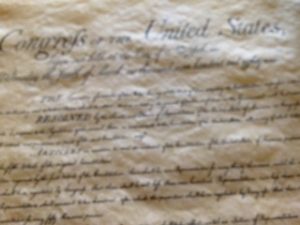 September 17 seems to have slipped by again kind of unnoted—no front page, above-the-fold headlines or below, for that matter, and no fireworks, either. Sort of just another day, made mention of but no hoopla. And so, though eight days late, I can’t let the month close out without talking about the Constitution, its set-aside day, and the current state of civics knowledge.
September 17 seems to have slipped by again kind of unnoted—no front page, above-the-fold headlines or below, for that matter, and no fireworks, either. Sort of just another day, made mention of but no hoopla. And so, though eight days late, I can’t let the month close out without talking about the Constitution, its set-aside day, and the current state of civics knowledge.
Just gotta.
As one Founding Father, Alexander Hamilton, noted, “If it be asked, what is the most sacred duty and the greatest source of our security in a Republic? The answer would be an inviolable respect for the Constitution and Laws — the first growing out of the last… A sacred respect for the constitutional law is the vital principle, the sustaining energy of a free government.”
So how are we doing?
According to the University of Pennsylvania’s Annenberg Public Policy Center’s (APPC) recent, nationally representative Constitution Day Civics Survey:
- Just 47% could name all three branches of the government; 25% couldn’t name even one.
- Just 55% knew what it means when the Supreme Court rules 5 to 4 on a case.
- As for the protections granted to us by the First Amendment:
-
- 63% cited freedom of speech
- 24% cited freedom of religion
- 20% cited freedom of the press
- 16% cited the right of assembly
- 6% cited the right to petition the government
- AND 26% couldn’t name/didn’t know any.
-
Of note: “An APPC analysis found that taking a high school civics class continues to be associated with correct answers to such questions.”
BUT… Despite all the current talk about teaching, testing, and curricula, a recent analysis of high school civics courses and requirements by the Center for American Progress, an independent, progressive policy institute, found that:
- Just 26 states meet “all five established civics curriculum requirements of:
- “Explanation or comparison of democracy
- The U.S. Constitution and the Bill of Rights
- Public participation
- Information on state and local voting rules
- The role and influence of media.”
- 40% of states require students take a civics exam to graduate.
- 66% address media literacy in their civics courses.
Why aren’t we talking more about all this?
To kick start your conversations, both at home and at school, head to such resources as:
*** https://bensguide.gpo.gov/search?q=constitution ~ Ben’s Guide provides a guide to the Constitution and our government for all, particularly kids.
*** https://constitutioncenter.org/education/civic-calendar/constitution-day-civic-holiday ~ Philly’s Constitution Center site offers nine Constitution Day related videos, together with other resources.
*** https://civics.archives.gov/ ~ Civics for All of Us offers student programs on everything from the Constitution to voting rights.
*** https://www.icivics.org/ ~ iCivics, founded by former Supreme Court Justice Sandra Day O’Connor, “engages students in meaningful civic learning…” and provides teachers (parents, too) with “well-written, inventive, and free resources.”
With many thanks and good school-wise wishes, too, Carol
Carol, Thanks again for another informative, timely article. Sadly, I think there are those in this country who are fine with the population being ignorant about the Constitution, and the rights it protects. Thus, it’s very easy to deny those same rights. An ignorant population is rife for transition into a socialist country!
Civics most important! Fortunately back in the day, I had a civics class and loved the teacher who taught the class, Mr. Brooks made civics come alive for me.
I love that he told you well; I love that you’ll never forget him and the lessons he taught you.